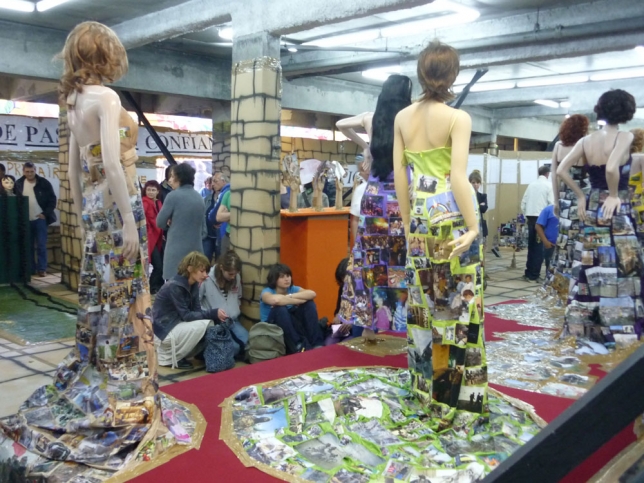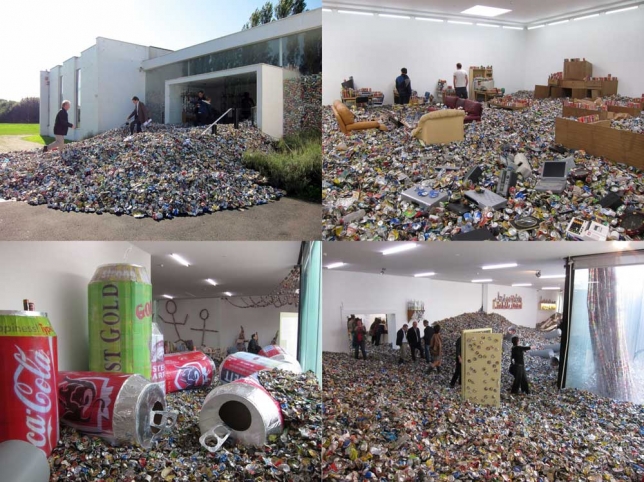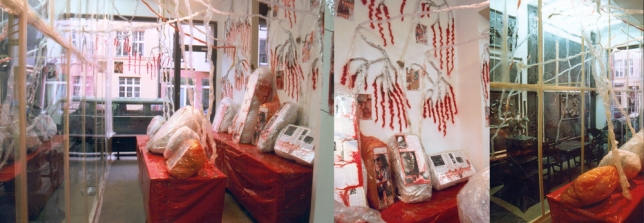17.07. - 04.09.1999
Thomas Hirschhorn (CH), Mathilde ter Heijne (NL), Susan Turcot (D/K), Via Lewandowsky (D)
Group exhibition at Arndt & Partner, Berlin
Thomas Hirschhorn
Born in 1957 in Bern, Switzerland
Lives and works in Paris, France
Thomas Hirschhorn is a Swiss artist who is known for his sprawling works that transform traditional white cube spaces into absorbing environments tackling issues of critical theory, global politics, and consumerism. He engages the viewer through superabundance. Combining found imagery and texts, bound up in low-tech constructions of cardboard, foil, and packing tape, he props imagistic assaults in a DIY-fashion that correlates to the intellectual scavenging and sensory overload designed to simulate our own process of grappling with the excess of information in daily life. Created from the most basic everyday materials, his monumental works are concerned with issues of justice and injustice, power and powerlessness, and moral responsibility.
The sister-piece of the work “Untitled (Ingeborg Bachmann)”, 1999, titled “Untitled (George Orwell)” has just been included in the collection of the Art Gallery of South Australia.
“A collage is an interpretation. An interpretation that wants to create something new. Doing collages means to create a new world with existing elements of this world. Everyone has once in his life made a collage and everybody is included in a collage. Collages possess the power to implicate the other immediately. I like the capacity of non-exclusion of collages and I like the fact that they are always suspiscious and not taken seriously. Collages still resist consumption, even if - like everything - they have to fight against glamorousness and fashionability. I want to put together what cannot be put together, I think that’s the aim of a collage and it’s my mission as an artist.” Thomas Hirschhorn
CV
Thomas Hirschhorn studied from 1978-83 at the Hochschule fuer Gestaltung in Zurich, Switzerland. His work has been the subject of numerous solo exhibitions including the Institute of Contemporary Art, Boston, USA, Centre Georges Pompidou, Paris, France, Museu d'Art Contemporani, Barcelona, Spain, Kunsthaus Zürich, Zürich, Switzerland, Art Institute of Chicago, Chicago, USA, Museum Ludwig, Köln, Germany, Museo Tamayo, Mexico, Institute of Modern Art Brisbane, Brisbane, Australia, Musée d’Art Contemporain, Montréal, Canada, CCA Wattis Institute, San Francisco, USA, Bonnefantenmuseum, Maastricht, The Netherlands, Pinakothek der Moderne, Munich, Germany, Kestnergesellschaft, Hannover, Germany, The Power Plant, Toronto, Canada, Dia Art Foundation, New York, USA and Secession, Vienna, Austria.
Additionally, he has taken part in many international group exhibitions, including Documenta 11 in Kassel, Germany, where his large-scale public work, Bataille Monument was on view as well as "Heart of Darkness" at the Walker Art Center, Minneapolis, USA and "Life on Mars" at the 55th Carnegie International, Pittsburgh, Pennsylvania, USA. In 2012-2013 Hirschhorn participated at the 9th Shanghai Biennale together with Sophie Calle.
Hirschhorn was the recipient of the Prix Marcel Duchamp in 2000 and the Joseph Beuys-Preis in 2004 and represented the Swiss Pavillon in the 54th Venice Biennial in 2011.
SELECTED COLLECTIONS
SMAK Stedelijk Museum voor Actuele Kunst, Gent; Belgium, FRAC - Collection Aquitaine, Bordeaux; France, Musée d'Art moderne de Saint-Etienne, Saint-Etienne; France, K21 Ständehaus, Dusseldorf; Germany; Stedelijk Museum Amsterdam, Amsterdam, Netherlands; Ellipse Foundation, Alcoitão, Portugal; Tate Britain, UK; Museum of Contemporary Art Chicago (MCA), Chicago, IL, USA; MoMA - Museum of Modern Art, New York City, NY, USA
EXHIBTIONS
29.4. - 30.5.2010
“Changing The World”
Group exhibition with works by Erik Bulatov, Sophie Calle, William Cordova, Wim Delvoye, Anton Henning, Thomas Hirschhorn, Ilya und Emilia Kabakov, Jitish Kallat, Jon Kessler, Karsten Konrad, Julije Knifer, Enrique Martinez Celaya, Josephine Meckseper, Vik Muniz, Muntean Rosenblum, Julian Rosefeldt, Charles Sandison, Dennis Scholl, Nedko Solakov, Hiroshi Sugito, Ena Swansea, Mathilde Ter Heijne, Keith Tyson, Ralf Ziervogel
at ARNDT, Berlin
14.11.08 – 14.01.09
"Sculpture Is ..."
Group exhibition with works by Veronika Brovall , William Cordova , Anton Henning , Mathilde ter Heijne , Thomas Hirschhorn , Jon Kessler , Douglas Kolk , Karsten Konrad
at Arndt & Partner, Berlin
27.04. – 07.07.07
Thomas Hirschhorn
“Stand-alone”
at Arndt & Partner, Berlin
15.10. – 20.11.2005
“Works on paper”
Group exhibition with works by Florian Baudrexel, Jonathan Hernández, Thomas Hirschhorn, Tam Ochiai, Muntean / Rosenblum, Dennis Scholl, Hiroshi Sugito and Keith Tyson
at Arndt & Partner, Berlin
14.12.2002- 30.1.2003
Thomas Hirschhorn
“Doppelgarage”
at Arndt & Partner, Berlin
10.03. – 14.04.2001
“Accrochage”
Group exhibition at Olaf Breuning, Sophie Calle, Thomas Hirschhorn, Via Lewandowsky, Max Mohr, Nedko Solakov, Mathilde ter Heijne, Susan Turcot, Massimo Vitali
at Arndt & Partner, Berlin
10.06. – 19.08.2000
Peter Friedl, Thomas Hirschhorn, Lawrence Weiner
at Arndt & Partner, Berlin
17.07. - 04.09.1999
Thomas Hirschhorn, Mathilde ter Heijne, Susan Turcot, Via Lewandowsky
at Arndt & Partner, Berlin
22.01. - 20.03.1999
Thomas Hirschhorn
"Das Bernsteinzimmer“
at Arndt & Partner, Berlin
18.04. - 13.06.1998
Thomas Hirschhorn
"Flipper mit roten Tränen“
at Arndt & Partner, Berlin
21.02. - 11.04.1998
RESOLUTION
Group exhibition with works by Sophie Calle, Peter Friedl, Dorothee Golz, Joseph Grigely, Thomas Hirschhorn, Fabrice Hybert, Jacques Julien, Johannes Kahrs, Douglas Kolk, Via Lewandowsky, Philippe Mairesse, Ulrich Meister, Bjarne Melgaard, Max Mohr, Marianne Müller, Nedko Solakov and Susan Turcot
at Arndt & Partner, Berlin
02.03. - 14.04.1996
Thomas Hirschhorn
"Virus Ausstellung"
at Arndt & Partner, Berlin
 Thomas Hirschhorn, Spinoza Car,"French Window: Looking at Contemporary Art through the Marcel Duchamp Prize", installation view: Mori Art Museum (2011/3/26-2011/8/28); Photo: Watanabe Osamu; Photo Courtesy: Mori Art Museum, 2009, Car, wood, paint, tape, cardboard, paper, marker, ball-point pen, transparent foil, stickers, books, magazines, prints, plastic toys, fans, mirrors, ceramic objects, clocks, audio cds, electric wire, lamps, notebooks, car gadgets
Thomas Hirschhorn, Spinoza Car,"French Window: Looking at Contemporary Art through the Marcel Duchamp Prize", installation view: Mori Art Museum (2011/3/26-2011/8/28); Photo: Watanabe Osamu; Photo Courtesy: Mori Art Museum, 2009, Car, wood, paint, tape, cardboard, paper, marker, ball-point pen, transparent foil, stickers, books, magazines, prints, plastic toys, fans, mirrors, ceramic objects, clocks, audio cds, electric wire, lamps, notebooks, car gadgets Théatre Précaire by Thomas Hirschhorn at Les Ateliers de Rennes - Biennale d’art contemporain until 18 July 2010
Exhibiting Poetry Today : Manuel Joseph - solo show by Thomas Hirschhorn
Exhibiting Poetry Today : Manuel Joseph
Until 26 September 2010
At CNEI (Centre national de l'estampe et de l'art imprimé), Chatou, France
A catalogue is accompanying the exhibition:
Exhibiting Poetry Today : Manuel Joseph - Format 21 × 29,7 cm - 512 pages – contributions by Alexandre Costanzo, Thomas Hirschhorn, Manuel Joseph, Olivier Quintyn, Marcus Steinweg – edited by: cneai= / Xavier Barral
“Perpetual Battles”, Baibakov Art Projects, Moscow, 2010
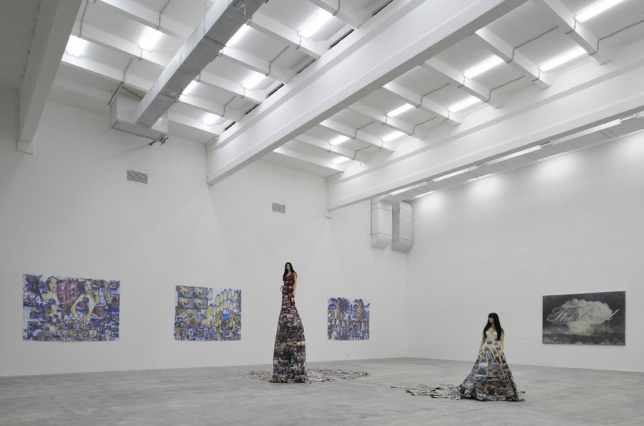 Thomas Hirschhorn, Exhibition view : “Perpetual Battles”, Baibakov Art Projects, Moscow, 2010
Thomas Hirschhorn, Exhibition view : “Perpetual Battles”, Baibakov Art Projects, Moscow, 2010
“Perpetual Battles”, Baibakov Art Projects, Moscow, 2010
Group exhibition with works by Thomas Hirschhorn until 25 July 2010
Intensif-Station – 26 Artist's Rooms in the K21 - Group show with works by Thomas Hirschhorn
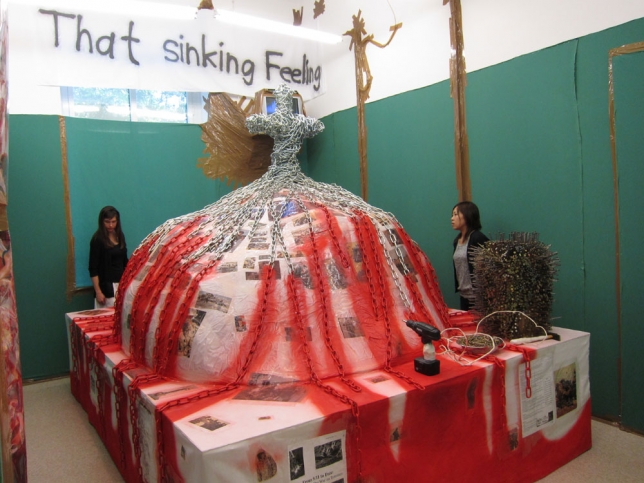 Thomas Hirschhorn, "Intensif-Station", 2010 Exhibition view: "Intensif-Station", K21 Ständehaus, Düsseldorf, 2010; Photo: Romain Lopez
Thomas Hirschhorn, "Intensif-Station", 2010 Exhibition view: "Intensif-Station", K21 Ständehaus, Düsseldorf, 2010; Photo: Romain Lopez
10 July 2010 – 04 September 2011
K21 Ständehaus, Düsseldorf
The Kunstsammlung am Grabbeplatz will reopen its refurbished and expanded building. An opening celebration will take place on 10 July 2010 at the Ständehaus, where the presentation Intensif-Station – 26 Artist's Rooms in the K21 will be on view until 04 Septembre 2010. In 26 different rooms, installations and ensembles of works owned by the Kunstsammlung will be supplemented by new rooms.
This exhibition was named after an installation by Thomas Hirschhorn which bears the same title, and whose theme is the intensity of the art experience.
Embedded Fetish by Thomas Hirschhorn at the 8th Gwangju Biennial
Too Too - Much Much - solo show by Thomas Hirschhorn at Museum Dhondt-Dhaenens, Deurle, Belgium
Thomas Hirschhorn - Das Auge (The Eye) at The Power Plant in Toronto
 Thomas Hirschhorn, Das Auge, 2008, Mixed media; integrated text, to take away, „Flat Red Flag“, by Manuel Joseph, circa 600m², Exhibition view: Thomas Hirschhorn, Isa Rosenberger, Miklós Erhardt, Secession, Vienna, 2008, HIRS0449
Thomas Hirschhorn, Das Auge, 2008, Mixed media; integrated text, to take away, „Flat Red Flag“, by Manuel Joseph, circa 600m², Exhibition view: Thomas Hirschhorn, Isa Rosenberger, Miklós Erhardt, Secession, Vienna, 2008, HIRS0449
The work „Das Auge (The Eye)” by THOMAS HIRSCHHORN will be sown at The Power Plant in Toronto from 9 March. The work, which was co-produced by us in 2008 for the Wiener Sezession, will be on view until 29 May – Thomas Hirschhorn will hold an artist talk in Toronto on 23 February.
Thomas Hirschhorn - Website announcement: www.crystalofresistance.com 54th International Art Exhibition in Venice
 Thomas Hirschhorn, website announcement: www.crystalofresistance.com for the 54th International Art Exhibition in Venice
Thomas Hirschhorn, website announcement: www.crystalofresistance.com for the 54th International Art Exhibition in Venice
Dear Friend,
would like to announce you that the website www.crystalofresistance.com has just been launched today:
- This website has been created to inform on my work «Crystal of Resistance» exhibited at the Swiss Pavilion on the occasion of the 54th International Art Exhibition in Venice, June 4 (public opening) – November 27, 2011,
- You can find there all kind of documents: texts, interviews, photos, sketches, and videos about «Crystal of Resistance»,
- The website will be updated continuously before and after the opening of the Biennale, and is time-limited: it will stay online for several months only (closing end January 2012),
- This website is neither an artwork, nor part of the artwork: «Crystal of Resistance»,
- This website has a "press-kit" section where everybody can download a zip archive which contains pictures and texts that they can (freely) use for publication
Take care, Take care
Thomas Hirschhorn
Thomas Hirschhorn participates the group exhibition "French Window. Looking at Contemporary Art through the Marcel Duchamp Prize" at the Mori Art Museum, Tokyo, Japan, 2011
 Thomas Hirschhorn, Spinoza Car,"French Window: Looking at Contemporary Art through the Marcel Duchamp Prize", installation view: Mori Art Museum (2011/3/26-2011/8/28); Photo: Watanabe Osamu; Photo Courtesy: Mori Art Museum, 2009, Car, wood, paint, tape, cardboard, paper, marker, ball-point pen, transparent foil, stickers, books, magazines, prints, plastic toys, fans, mirrors, ceramic objects, clocks, audio cds, electric wire, lamps, notebooks, car gadgets
Thomas Hirschhorn, Spinoza Car,"French Window: Looking at Contemporary Art through the Marcel Duchamp Prize", installation view: Mori Art Museum (2011/3/26-2011/8/28); Photo: Watanabe Osamu; Photo Courtesy: Mori Art Museum, 2009, Car, wood, paint, tape, cardboard, paper, marker, ball-point pen, transparent foil, stickers, books, magazines, prints, plastic toys, fans, mirrors, ceramic objects, clocks, audio cds, electric wire, lamps, notebooks, car gadgets
Exhibition:
"French Window. Looking at Contemporary Art through the Marcel Duchamp Prize"
Mori art Museum, Tokyo, Japan
26 March to 28 August 2011
For ten years, an elite association of contemporary art collectors known as ADIAF has hosted what has become one of France’s most prestigious art awards, the Marcel Duchamp Prize. To celebrate the award’s first decade, this exhibition presents the work of 28 artists, including all of the winners of the Grand Prix, selected finalists and also Duchamp himself.
The exhibition’s title refers to Duchamp’s well known work Fresh Widow, which depicts a French window, and a similar theme is continued through the show’s five sections: "Duchamp's Window," "The View from the Window," "The Window of Time and Space," "The Window of the Inner World" and "Inside the Window." Together, they provide a comprehensive view of the contemporary French art scene. The exhibition begins with important works by Duchamp himself, and then presents the esprit of contemporary French art through a selection of paintings, sculptures, photographs, installations and videos made by artists of diverse ages and cultural backgrounds. The final section includes a re-creation of a French collector's apartment, complete with artworks.
The exhibition provides an opportunity to experience contemporary French art as it exists today – a unique expression of the nation’s psychological landscape – and at the same time it provides insight into how the collectors of this art incorporate it into their own lives. We hope visitors are inspired to contemplate for themselves the nature of art and life as well as the role that collectors can play in any art scene.
Thomas Hirschhorn - UPCOMING EXHIBITIONS FALL 2011
"Kunst und Philosophie"
n.b.k. Neuer Berliner Kunstverein, Berlin
3 September - 30 October 2011
Opening 2 September 2011
"Terrible Beauty: Art, Crisis, Change & The Office of Non-Compliance"
Dublin Contemporary 2011
6 September - 31 October 2011
"ERRE Variations Labyrinthiques"
Centre Pompidou-Metz
10 September 2011 - 5 March 2012
"The Uncanny Familiar. Images of Terror"
C/O Berlin. International Forum For Visual Dialogues, Berlin
10 September - 4 December 2011
"September 11"
MoMA PS1, Long Island City, New York
11 September 2011 - 9 January 2012
Solo show
La Douane, Galerie Chantal Crousel, Paris
22 September - 25 November 2011
Inhotim, Belo Horizonte, Brazil
6 October 2011 -
Solo show
Kurt-Schwitters Preis
Sprengel Museum Hannover
20 November 2011 -
UPCOMING CONFERENCES:
Schaulager Basel
18 November 2011
Institut für Gegenwartskunst, Zürich
1 December 2011
Princeton
December 2011
ARNDT represents Thomas Hirschorn with his series "Des Larmes" (tears) and one special single work at abc - art berlin contemporary
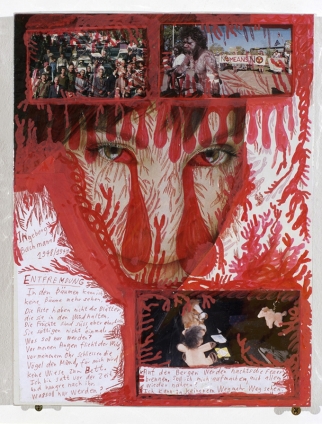 Thomas Hirschhorn, Ohne Titel , 1998, collage made of wood, plastic foil marker, ballpoint, photo, elements of card, tape, 36 x 27,5 x 2 cm | 14.17 x 10.83 x 0.79 in
Thomas Hirschhorn, Ohne Titel , 1998, collage made of wood, plastic foil marker, ballpoint, photo, elements of card, tape, 36 x 27,5 x 2 cm | 14.17 x 10.83 x 0.79 in
ARNDT represents at this year's abc - art berlin contemporary Thomas Hirschhorn. We will show works from his series "Des Larmes" (tears) from 1998 as well as a very special single work titled "Ingeborg Bachmann" also from 1998. Please click here, to view the works.
abc - art berlin contemporary
7 - 11 september 2011
ARNDT is in hall1, wall 20a
"Eye to Eye Subjecter" on view at n.b.k. Neuer Berliner Kunstverein, Berlin
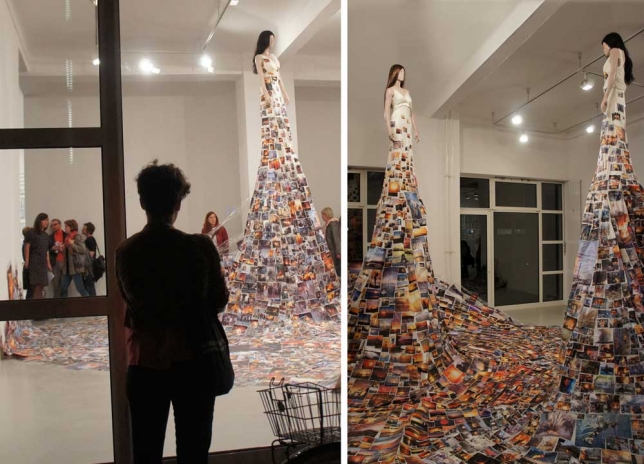 Thomas Hirschhorn, Eye to Eye-Subjecter, 2010, Mannequin, dress, paper print, brown tape, transparent tape, wood: approx., 420 x 530 x 930 cm | 165.35 x 208.66 x 366.14 in, HIRS0562; exhibition view "Kunst & Philosophie" at NBK, Berlin, 2011, Photo: Anna Kowalska
Thomas Hirschhorn, Eye to Eye-Subjecter, 2010, Mannequin, dress, paper print, brown tape, transparent tape, wood: approx., 420 x 530 x 930 cm | 165.35 x 208.66 x 366.14 in, HIRS0562; exhibition view "Kunst & Philosophie" at NBK, Berlin, 2011, Photo: Anna Kowalska
"Art and Philosophie"
n.b.k. Neuer Berliner Kunstverein, Berlin
Group exhibition
3 September – 30 October 2011
Exhibitions
27.04. – 07.07.07
Thomas Hirschhorn
“Stand-alone”
Solo exhibition at Arndt & Partner, Berlin
PRESS RELEASE
Arndt & Partner is pleased to present its fourth solo show of the Swiss artist Thomas Hirschhorn, to mark the opening of the Third Berlin Gallery Weekend.
Thomas Hirschhorn's sculptural constructions and environments are famous for transporting knowledge and information by alienating the usual means of presentation and skewing our perspective on things. To achieve this, Hirschhorn frequently favours elaborate, expansive installations, seemingly chaotic structures that use everyday materials that are nonetheless symbolically charged. Hirschhorn's spatial assemblages are skilful stagings of the imperfect, wild associative landscapes whose energies are intended to inspire thought, as Hirschhorn himself stresses: "I don't want to make interactive art, I want to make active art, work that activates the brain." The result are installations where the beholder has to engage with signs, symbols, and memories, and which change our perspective on the possibilities of art and life.
In Hirschhorn's new work "Stand-alone", which will extend over all four rooms of our Gallery 1st Floor, the beholder also is confronted with the richness of visual materials that is so typical for the artist, materials that make connections between apparently unconnected things. Kicked-in doors, sofas and armchairs wrapped in tape, are made equal by their wrapping and placed next to each other. Cardboard fireplaces, old electronic devices, wood, clocks, books, and other documents form a spatial collage, the purpose of which is "to create a new world from elements of the old one." Without pretension and exceedingly cleverly, Hirschhorn succeeds in creating a sense of profusion, chaos, and the potential of conflict that goes hand in hand with the experience of current life worlds.
In his latest exhibition, Thomas Hirschhorn is showing a three-dimensional realisation of his plan "Where do I stand? What do I want?" (which is available for visitors of the gallery) that thematizes the question of the artist's own position, possibilities of giving form, and independence in terms of content. "How can I make a work that doesn't in any way subject itself to historical facts? And how can I make a work that touches the beyond of history (which I live in)? How can I make in the current - my historical filed - make a super-historical work?"
Faithful to his unique way of giving form, the confusing architecture of his latest installation follows its own artistic logic. And if apparently excessive demands are raised to a principle of form giving, this is informed in Hirschhorn by a concept, because "chaos is the world in which I live, and chaos is the time in which I live," as he explains. Art, on the other hand, for him is a tool "to get to know the world, to confront it, to experience the age in which I live."
The choice of materials is also a conscious political decision. The cheap product packaging materials of the consumer goods industry for Hirschhorn are an appropriate, stringently used means of expression for his socially critical art. In them, his resistance against cultural grievances is articulated, as is a revolt against capitalisms desires, which Hirschhorn translated into a state of permanent creative anarchy. Available in every household, because of their everyday familiarity they avoid any appearance of exclusiveness, and thus underline the inclusion of the beholder which is so important to Thomas Hirschhorn: "Stand-alone is, as always, made for a non-exclusive audience, and as always, I want to include without neutralising, I don't want to exclude anybody."
With "Stand-alone", Thomas Hirschhorn once again reveals his ability to translate, through his aggressive visual worlds, political ideas and philosophical language into an accessible understandable language, to create reference and literally create new spaces for ideas and engagements. The result are art productions that make no aesthetic claims, but instead call for confrontation and dialogue about existing conditions, and which the New York Times considers "some oft the best being made today."
Thomas Hirschhorn was born in 1957 in Berne; from 1978 to 1983 he was a student at the Schule für Gestaltung in Zurich. Since the mid-1990s, he has gained international acclaim for his installations, and today he is considered one of the most important artists of his generation. He has been living and working in Paris since 1984. His works have been shown in countless solo and group exhibitions. He conceived and realised more than 50 works for public spaces.
14.12.2002- 30.1.2003
Thomas Hirschhorn (CH)
“Doppelgarage”
Solo exhibition at Arndt & Partner, Berlin
PRESS RELEASE:
THOMAS HIRSCHHORN DOUBLE GARAGE
On the integrated texts by Marcus Steinweg:
I will write at least ten texts each of which can be read on its own. At the same time there is a thematic cohesion to the texts consisting in the common presence of Nietzschean motifs. Each of these texts is closed within itself and intact. They are texts which have been made available to Thomas Hirschhorn as material for his Double arage. The texts will be integrated into the work, either magnified or reduced in size, as required. Just as my contribution to the Bataille monument in Cassel represents the attempt to go beyond Bataille to the thinking of the present, these texts too are not supposed to be texts about Nietzsche. They are texts beyond Nietzsche. It is a matter of appropriating the problems of Nietzsche’s thinking – with Nietzsche and without him –, to demonstrate and to re-activate the continuity and pertinence of his motifs for today’s political philosophy. The critique of Christianity and its anti-life doctrine will be examined with respect to the extent to which the birth of economic liberalism (capitalism) out of the spirit of resentment and revenge (that is, from that ideology which Nietzsche links to an essential unfreedom) opens up the question concerning the possibility of a second birth of freedom, a freedom which eludes the economy of rights and its politics of compensatory justice.
From here a revision or revaluationf all the concepts and categories of moral philosophy results. An altered concept of action, politics and practical reason becomes necessary which with the re-erection of the philosophical category of the subject extends the subject’s responsibility into infinity in order to withdraw it from the (postmodern or late capitalist) protectorate of its constitutive impotence. Seen in this way, Nietzsche would be not so much the thinker of perspectival illusionism or relativism, but rather the philosopher of irreducible, unsharable and ungroundable responsibility, a responsibility which is also a name for freedom insofar as Nietzschean discourse, in struggling against Christianity, also struggles against the entanglement of the Christian subject inguilt, pangs of conscience and resentful cowardice. To declare war on Christianity means for Nietzsche at first (and that is the point where he touches on Spinoza and Deleuzian Spinozism) to vitalize the subject within the horizon of a responsibility which isolates it and to redefine it through the body and its sensuous capabilities. “To annihilate the passions and desires simply in order to prevent their stupidity seems to us today to be itself merely an acute form ofstupidity. We no longer admire the dentists who extract teeth so that they can no longer cause pain…” (Götzen-Dämmerung, KSA 6, p. 82) The subject of responsibility is a sensuous subject, not a sentimental one. It is sensible without being
sensitive, narcissistic or whingeing. It does not avoid every act of cruelty in order to be responsible vis-à-vis the real which in itself is a kind of violence and cruelty, a kind of brutal asymmetry. And Nietzsche does not tire from evoking this cruelty with diverse names, citing and recapitulating it, so to speak, in order not to share with those whom
he calls his enemies the displeasure, credulity, naivety and fearfulness which are supposed to protect against life and becoming as such. The praise of cruelty unfolds as a recognition of the multiplicities and irreducibility of the contradictions and differences and their conflict. “The decisive feature in a Dionysian philosophy, saying yes to contradictions and war, to becoming…” (Ecce Homo KSA 6, p. 313). The grand politics which nature expects of himself and Nietzscheanism is a politics of difference, of instability and permanent development, a politics of affirmation of the open and the undecided, i.e. of the undecidability of every difference. It is neither a politics of heteronomous, totalitarian, dictatorial and always negative, disempowering incapacitation, nor does it correspond to the anticipative, a priori weakened morality of the levelling of every form of difference and otherness (at
present it is above all Slavoj Zizek who speaks up against this always insincere morality of capitalist multiculturalism and its repressive and, one must add, resentful tolerance, thoroughly in the sense in which Nietzsche appraises as an invention of Goethe, “the tolerant human, not out of weakness but out of strength,” Götzen-Dämmerung, KSA 5, p. 151). The tasks which arisefor reactivating and affirmativelytaking up Nietzsche’s olitical ontology must first reject these two errors, the two figures of “false relatedness”, a relatedness which, as Deleuze says, “can be found inthe train of every ‘cursed thinker’ (penseur maudit)”: . The assimilation of this thinking into Nazism and anti-Semitism promoted by Nietzsche’s sister, Elizabeth Nietzsche, whose obvious falseness and absurdity happily seems to be generally recognized today and 2. The other also scarcely acceptable
reduction of Nietzsche to his (undoubtedly imposing and affirmable) Europeanism and cosmopolitanism, etc., that is, the reduction of Nietzsche to the good Nietzsche which makes itself guilty of a further censorial defusing of his work. (One should take Nietzsche seriously even where it hurts!) To open Nietzsche up to the presentmeans rhaps first of all – and that would be an act of political and not just philological responsibility – to deal responsibly with his texts even there where they are not closed to the experience of a cruelty which is today lmost taboo, but to mobilize this cruelty which by definition represents an excessive demand for any thinking, as an excessive demand on one’s own thinking instead of enclosing oneself in the phantasma of a future which is spared cruelty. Non-liberalist freedom therefore represents the condition of possibility of the most extreme responsibility (which is always also responsibility towards what is most extreme, towards cruelty and the absolute otherness of the other) as well as its highest degree of endangering. I will try to show that Nietzsche’s insight into the equiprimordiality of ethicity which is not morality and the violence which threatens it steers all his movements in thinking and that the denial and negation of this equiprimordiality is part of the conscious or unconscious hypothesis of all ideological systems, whether they be primarily political, economic, social, religious or ontological dispositives, whose concrete cruelties are witnessed by history in general. If to think with Nietzsche means to think dangerously in a certain sense, then this also means that a strong and uncompromising concept of responsibility, of communication, ethicity, justice and decision is necessary, the redefinition of freedom as the responsibility to freedom and the freedom to responsibility in order to withdraw the subject from the control of morality, the imperative of conscience, history, society and its opinions (doxa) and its pathos of self-righteousness. Subjectivity can only be thought as this continual conflict. Marcus Steinweg Marcus Steinweg, born in 1971, author of hilosophical and literary texts, lives in Berlin. His latest publications are: „Krieg der différance“ and „Autofahren mit acan“ (both Koblenz 2001) and „Der Ozeanomat. Ereignis und Immanenz“ Cologne 2002). Coming soon: „Bataille Maschine“ (Merve Verlag, Berlin 2003). Translated from the German by Michael Eldred, artefact text & translation, Cologne .
22.01. - 20.03.1999
Thomas Hirschhorn (CH)
„Das Bernsteinzimmer“ - "The amber-room"
Solo exhibition at Arndt & Partner, Berlin
02.03. - 14.04.1996
Thomas Hirschhorn (CH): „Virus Ausstellung“
Solo exhibition at Arndt & Partner, Berlin
